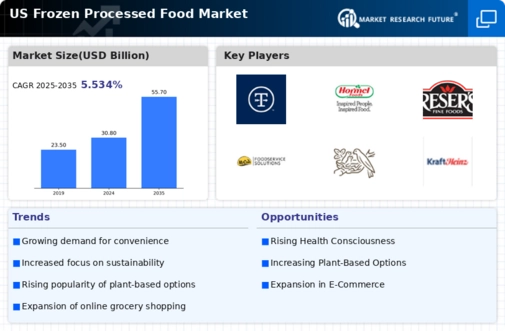Rising Demand for Plant-Based Options
The frozen processed-food market is experiencing a notable shift towards plant-based offerings. This trend is driven by an increasing number of consumers seeking healthier and more sustainable dietary choices. According to recent data, the plant-based food sector has seen a growth rate of approximately 27% in the past year alone. This surge indicates a significant opportunity for manufacturers to innovate and expand their product lines to include frozen plant-based meals and snacks. As consumers become more health-conscious, the frozen processed-food market is likely to adapt by incorporating more plant-derived ingredients, thereby appealing to a broader audience. This shift not only caters to dietary preferences but also aligns with environmental sustainability goals, making it a pivotal driver in the industry.
Growing E-commerce and Online Grocery Shopping
The rise of e-commerce is transforming the way consumers purchase frozen processed foods. With the increasing popularity of online grocery shopping, consumers are now able to access a wider range of frozen products from the comfort of their homes. Recent statistics show that online grocery sales have surged by over 25% in the last year, indicating a shift in consumer purchasing behavior. This trend presents a unique opportunity for frozen processed-food market players to enhance their online presence and distribution strategies. By leveraging e-commerce platforms, companies can reach a broader audience and cater to the growing demand for home delivery services. This shift towards online shopping is likely to continue influencing the frozen processed-food market in the coming years.
Technological Advancements in Food Preservation
Technological innovations in food preservation techniques are playing a crucial role in the frozen processed-food market. Advances such as flash freezing and improved packaging methods enhance the quality and shelf life of frozen products. These technologies help maintain the nutritional value and taste of food, which is increasingly important to consumers. For instance, the implementation of modified atmosphere packaging has been shown to extend the freshness of frozen items by up to 30%. As a result, manufacturers are better equipped to meet consumer demands for high-quality frozen meals. This focus on technology not only improves product offerings but also strengthens the competitive edge of companies within the frozen processed-food market.
Increased Focus on Convenience and Time-Saving Solutions
The fast-paced lifestyle of consumers is driving a heightened demand for convenience in the frozen processed-food market. Busy individuals and families are increasingly seeking quick meal solutions that do not compromise on quality. Data indicates that ready-to-eat frozen meals have seen a sales increase of approximately 15% over the past year. This trend suggests that consumers are prioritizing time-saving options, leading to a rise in the availability of single-serve and family-sized frozen meals. As a result, manufacturers are likely to expand their product lines to include a variety of convenient options, catering to the needs of a diverse consumer base. This focus on convenience is a significant driver in shaping the future of the frozen processed-food market.
Health and Wellness Trends Influencing Product Development
The increasing emphasis on health and wellness is significantly impacting product development within the frozen processed-food market. Consumers are becoming more discerning about the nutritional content of their food, leading to a demand for healthier frozen options. Recent surveys indicate that approximately 60% of consumers are actively seeking frozen meals that are low in sodium, sugar, and unhealthy fats. This trend encourages manufacturers to reformulate existing products and develop new offerings that align with health-conscious consumer preferences. As a result, the frozen processed-food market is likely to see a rise in products fortified with vitamins, minerals, and other beneficial ingredients. This focus on health and wellness is a critical driver shaping the future landscape of the industry.

















Leave a Comment